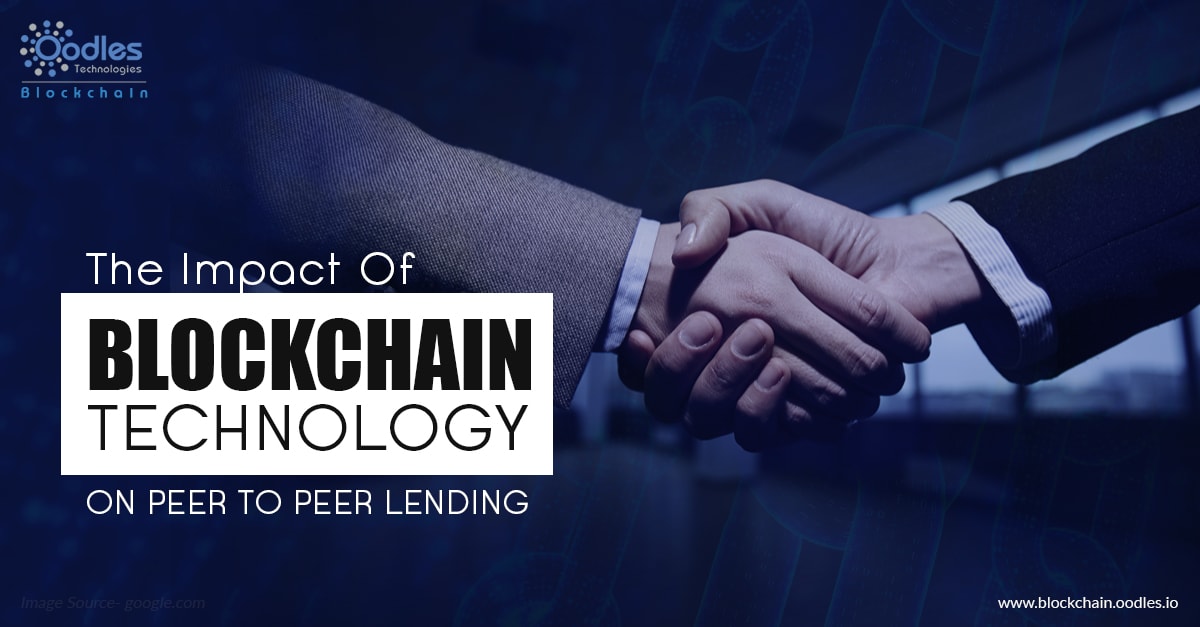-
Blockchain technology has taken center stage in the financial industry over the past decade, offering a groundbreaking approach to data storage, security, and transaction validation. As the world explores new ways to move beyond traditional banking structures, peer-to-peer (P2P) lending platforms have emerged as a compelling alternative to conventional financing. By connecting borrowers and lenders directly, P2P lending platforms developed levereging DeFi development services aim to deliver faster, cheaper, and more transparent services than traditional banks. The marriage of P2P lending with blockchain technology has the potential to revolutionize the financial services landscape and open new avenues for businesses. In this blog, we will explore the intricate world of blockchain technology, its relevance to peer-to-peer lending, and its far-reaching implications for businesses seeking to harness this powerful synergy.
In this discussion, we will cover:
- An overview of P2P lending and how it challenges the status quo of conventional lending
- A technical overview of blockchain technology and how it applies to lending processes
- The key benefits and challenges in implementing blockchain-driven P2P lending solutions
- The broader financial implications, regulatory considerations, and future outlook
- Answers to frequently asked questions (FAQ) to clarify critical points
By the end of this comprehensive blog, you will have a clear understanding of how businesses can leverage blockchain-driven P2P lending solutions to minimize costs, reduce friction, and enhance trust and transparency in lending operations.
What Is Peer-to-Peer Lending?
Peer-to-peer lending, often referred to as P2P lending, is an alternative form of financing that directly connects lenders and borrowers via an online platform or marketplace. Instead of working through a traditional bank or credit union, individuals or businesses can lend capital to other individuals or businesses with minimal intermediation. This lending model is designed to streamline and democratize the lending process by removing many of the overhead costs and administrative bottlenecks commonly found in traditional banking.
Key Characteristics of P2P Lending
Direct Connection: P2P lending platforms serve as a marketplace where lenders can choose whom to lend to based on criteria such as creditworthiness, risk tolerance, and loan terms.
Lower Costs: By removing the traditional bank from the transaction, both borrowers and lenders often enjoy lower interest rates and reduced fees.
Risk Diversification: Lenders can spread their capital across various borrowers to diversify their portfolios and mitigate default risks.
Technology-Driven: P2P lending platforms run online and leverage algorithms, data analytics, and now increasingly, blockchain technologies to facilitate and secure transactions.
P2P lending has grown in popularity over the last decade, particularly in markets where credit options are limited or traditional banking practices are perceived as inefficient. However, the involvement of intermediaries—platform operators—can still present issues such as lack of transparency, potential data breaches, and conflicts of interest. This is where blockchain technology can make a substantial impact.
Also, Read | AI-Based P2P Lending Platform Development
Blockchain Technology: A Brief Overview
Blockchain is a decentralized, distributed ledger technology that allows secure, transparent, and tamper-proof record-keeping across a network of computers (nodes). Rather than relying on a central authority to validate transactions, a blockchain network uses consensus mechanisms (like Proof of Work, Proof of Stake, or others) to verify the legitimacy of transactions. The fundamental attributes of blockchain include:
Decentralization: The ledger is not maintained by a single authority but by multiple nodes distributed across the globe. This removes single points of failure and enhances security.
Transparency: Each transaction is publicly recorded, and network participants can view the transaction history.
Immutability: Once data is added to the blockchain, it cannot be altered without altering every subsequent block—a highly improbable feat due to cryptographic hashes and consensus requirements.
Security: Advanced cryptographic methods ensure that the ledger is resistant to tampering.
Smart Contracts: Programs that automatically execute contract terms when predefined conditions are met. Smart contracts further automate processes and reduce the need for middlemen.
For the financial industry, particularly lending, these characteristics can transform how loans are issued, managed, and repaid. Smart contracts, coupled with a distributed ledger, can reduce operational costs, increase transparency, and build trust among participants who may have never interacted before.
Also, Explore | Unlocking Value: Exploring the World of NFT Lending
The Key Benefits of Blockchain in P2P Lending
Blockchain-driven P2P lending comes with a multitude of benefits that aim to correct many of the inefficiencies of traditional lending models. These benefits range from improved transparency to lower operational costs. Below are some of the primary advantages of integrating blockchain into a peer-to-peer lending framework.
Transparency & Trust
- Improved Visibility: By utilizing blockchain, every transaction and agreement is recorded on an immutable ledger accessible to all authorized participants. This transparency allows lenders to track how borrowed funds are utilized and provides borrowers with clarity on the terms of repayment.
- Enhanced Credibility: Publicly verifiable records on blockchain improve trust among stakeholders. Lenders can more easily verify a borrower's loan history, and borrowers can demonstrate their creditworthiness through on-chain data.
- Reduced Fraud: Blockchain's tamper-proof nature significantly mitigates the risk of fraudulent transactions or manipulated records. Any attempt to alter existing data in the blockchain would immediately alert the network, acting as a strong deterrent to fraud.
Disintermediation & Cost Efficiency
- No Centralized Authority: Because blockchain systems do not require a single controlling entity, middlemen like banks or payment gateways can be sidestepped. This disintermediation reduces costs and speeds up the lending process.
- Lower Transaction Fees: Using blockchain for fund transfers can be cheaper than conventional methods, especially for cross-border transactions. Smart contracts automate much of the lending workflow, reducing administrative and operational expenses.
- Streamlined Processes: The automation of loan underwriting, funds disbursement, and repayment collection via smart contracts enables frictionless and faster operations, which can be critical for businesses looking to manage liquidity efficiently.
Immutable & Secure Transaction Records
- Data Integrity: Once information is recorded on a blockchain, it becomes nearly impossible to edit without consensus from the network. This gives an additional layer of security for loan agreements and repayment records.
- Immutable Auditing: Regulators, investors, and other stakeholders can rely on an immutable audit trail for compliance and due diligence. This feature is invaluable for ensuring that all parties involved act in accordance with regulations and contract terms.
- Regulatory Confidence: Clear, transparent, and tamper-resistant data can make it easier for regulatory bodies to validate compliance, which can lead to smoother regulatory approval processes.
Also, Check | NFT Lending and Borrowing | When NFT Meets DeFi
Challenges to Implementing Blockchain in P2P Lending
While the benefits are convincing, adopting blockchain technology for P2P lending is not without its challenges. From scalability issues to regulatory hurdles, businesses need to navigate a complex landscape to fully leverage this new paradigm.
Scalability & Transaction Speed
- Network Congestion: Public blockchains like Ethereum can suffer from high network congestion, resulting in slower transaction speeds and higher gas fees. This can undermine the cost benefits that blockchain promises.
- Scaling Solutions: Layer-2 solutions, sidechains, or alternative blockchain platforms can offer improved throughput, but adopting these solutions may present additional technical hurdles and require specialized expertise.
- Lender and Borrower Experience: If transactions are too slow or fees are unpredictable, it could deter mainstream adoption. Thus, finding the right blockchain platform or scaling strategy is essential for a seamless user experience.
Regulatory and Compliance Hurdles
- Jurisdictional Differences: Regulatory frameworks vary from one country to another. P2P lending platforms that operate across multiple jurisdictions must ensure they comply with each region's legal requirements—often a complex endeavor.
- KYC/AML Requirements: Anti-money laundering (AML) and Know Your Customer (KYC) protocols are vital in financial services. Incorporating these protocols into a decentralized model is feasible, but complex, especially if the blockchain is public and permissionless.
- Legal Recognition of Smart Contracts: In many countries, the legal framework for smart contracts remains unclear or insufficiently tested in courts, creating uncertainty for businesses adopting these technologies.
User Adoption & Education
- Complexity of Technology: Blockchain, smart contracts, and decentralized finance (DeFi) can be daunting for non-technical users. This technological complexity can hinder widespread adoption of blockchain-based P2P lending platforms.
- User Onboarding: For businesses aiming to launch a P2P lending solution, creating a user-friendly interface with streamlined onboarding processes is paramount. Overly complex interfaces can discourage participation, no matter how beneficial the underlying technology might be.
- Awareness & Trust: Despite rising interest in blockchain, there remains a gap in understanding. Businesses must invest in educational resources, marketing, and user support to build trust and familiarity among potential lenders and borrowers.
Also, Discover | Defi Lending and Borrowing Platform Development
Potential Use Cases and Implementation Strategies
Numerous use cases emerge when we consider integrating blockchain into P2P lending systems. From microloans to corporate financing, the potential spans various segments of the lending ecosystem.
- Microfinance in Developing Economies
- Small borrowers who lack traditional credit histories can access loans through blockchain-based P2P platforms.
- Smart contracts and on-chain credit scoring reduce overhead costs, enabling lenders to offer more favorable loan terms.
- Corporate Lending and Invoice Financing
- Businesses with urgent liquidity needs can leverage blockchain platforms to secure loans directly from investors.
- Automated repayment structures and real-time tracking of invoices make this approach transparent and efficient.
- Collateralized Loans Using Tokenized Assets
- Borrowers can tokenize real-world assets (e.g., real estate, intellectual property) and use them as collateral on blockchain-based lending platforms.
- Lenders gain confidence in the security of their investments, thanks to transparent and immutable ownership records.
- Crowdfunding and Crowdlending
- Startups and SMEs can launch fundraising campaigns where participants fund their projects in exchange for tokens or a stake in future earnings.
- Streamlined, global reach via blockchain reduces geographical barriers to entry.
For businesses, the path to implementing these use cases generally involves:
- Selecting the Right Blockchain Network: Assess public vs. private vs. consortium blockchains.
- Building or Adopting Existing Smart Contract Frameworks: Use existing templates or develop from scratch for unique needs.
- Ensuring Regulatory Compliance: Incorporate robust KYC/AML mechanisms and work closely with legal advisors.
- Strategic Partnerships: Collaborate with fintech companies, blockchain consortia, or technology vendors who have expertise in DLT (Distributed Ledger Technology).
You may also like | Blockchain P2P Lending Platform | Revolutionizing Lending
Future Outlook
Blockchain technology's impact on P2P lending is still in its nascent stages. However, the pace of innovation hints at a future where:
Mainstream Adoption: As solutions become more user-friendly and scalable, the likelihood increases that both retail and institutional participants will adopt blockchain-based P2P lending for a portion of their lending or borrowing activities.
Evolving Regulation: Governments worldwide are gradually shaping regulatory frameworks to accommodate cryptocurrencies, tokenization, and DeFi applications. A clearer legal environment will reduce uncertainty and encourage more players to enter the market.
New Financial Instruments: Tokenization of traditional assets—such as bonds, stocks, or real estate—can offer a broader range of collateral options for borrowers on P2P lending platforms. This could further lower barriers to entry.
AI-Driven Lending Decisions: Artificial intelligence and machine learning will likely integrate with blockchain-based lending platforms to enhance credit scoring and risk assessment, improving the match between lenders and borrowers.
Cross-Platform Interoperability: As different blockchain solutions mature, interoperability protocols (e.g., Polkadot, Cosmos) could allow seamless data and asset transfers between various blockchains, expanding the liquidity pool and diversifying risk.
For businesses, the growing synergy between blockchain and P2P lending suggests an array of opportunities—ranging from new revenue models to improved client engagement. Organizations that are quick to adapt may gain a competitive edge in the rapidly evolving fintech landscape.
Conclusion
The confluence of blockchain technology and peer-to-peer lending presents a game-changing opportunity for businesses seeking innovative financing models. By eliminating middlemen, enhancing transparency, and automating administrative tasks, blockchain can solve many of the historical inefficiencies of traditional lending systems. The immutable nature of blockchain also provides lenders, borrowers, and regulators with unprecedented levels of trust and security.
However, this transformation doesn't come without challenges. Scalability, regulatory uncertainty, and user adoption barriers remain significant hurdles that must be addressed. Despite these challenges, the trajectory for blockchain-powered P2P lending appears overwhelmingly positive. As more businesses experiment with decentralized finance solutions, we can anticipate a new era of lending that is more inclusive, efficient, and transparent than ever before.
Whether you're a fintech startup, an established enterprise looking to diversify, or an investor wanting to capitalize on emerging opportunities, now is the time to pay attention to blockchain-driven P2P lending. By staying informed about technological innovations, regulatory changes, and market trends, businesses can position themselves to reap the long-term rewards of this burgeoning sector.
You might be interested in | Developing P2P (Peer-to-Peer) Lending Platform with Blockchain
Frequently Asked Questions (FAQ)
Q1: How does blockchain differ from traditional databases in the context of P2P lending?
A1: Traditional databases are usually centralized and controlled by one organization. If that database is compromised or altered, the entire system's data integrity may be at risk. Blockchain, on the other hand, is decentralized and distributed across multiple nodes. This makes data tampering extremely difficult and ensures that all participants can verify the authenticity of the stored data. In the context of P2P lending, this decentralization increases transparency, trust, and reliability.
Q2: Are blockchain-based P2P lending platforms legal?
A2: The legality of blockchain-based lending platforms varies by jurisdiction. Many countries are adopting regulations to oversee crypto assets, security tokens, and DeFi applications. It is crucial for businesses to consult legal experts in the regions where they plan to operate to ensure compliance with relevant laws, such as securities regulations, KYC/AML requirements, and consumer protection acts.
Q3: What role do smart contracts play in blockchain-based P2P lending?
A3: Smart contracts are self-executing contracts with the terms directly written into code. In blockchain-based P2P lending, smart contracts can automatically manage tasks like disbursement of loan funds, accrual of interest, and repayment schedules. This automation significantly reduces administrative overhead, minimizes the possibility of human error, and enhances trust between borrowers and lenders.
Q4: How secure are blockchain-based lending platforms against cyberattacks?
A4: While no system is entirely immune to cyber threats, blockchain offers robust security features. Its decentralized nature removes single points of failure, and cryptographic hashing secures data. However, the applications built on top of blockchains (including smart contracts and user interfaces) can be vulnerable if not properly audited or secured. Ongoing code reviews, third-party security audits, and best practices in private key management are essential to maintaining strong security.
Q5: How can businesses integrate blockchain-based lending solutions without overhauling their entire IT infrastructure?
A5: Many blockchain platforms and third-party providers offer APIs and development frameworks that allow businesses to integrate decentralized functionalities incrementally. Hybrid solutions can also be adopted, where certain parts of the lending process (e.g., identity verification, credit scoring) remain centralized, while blockchain manages the lending agreements and fund transfers. This modular approach enables organizations to experiment and scale up as they gain confidence in the technology and address regulatory compliance aspects.
Q6: What are the primary obstacles preventing mainstream adoption of blockchain-based P2P lending?
A6: The main obstacles include regulatory uncertainty, lack of user awareness and education, and the technical challenges related to scalability and transaction throughput. Additionally, designing user-friendly interfaces that abstract away the complexity of blockchain is crucial for attracting non-technical participants. Overcoming these obstacles requires concerted efforts by platform developers, regulators, and industry stakeholders.
Q7: Can blockchain-based P2P lending coexist with traditional banking systems?
A7: Yes. In many cases, blockchain-based P2P lending will coexist and even collaborate with traditional banking systems. Banks might integrate blockchain solutions for specific processes like loan origination or asset tokenization. Over time, we may see more partnerships between traditional financial institutions and decentralized lending platforms to offer a mix of products catering to diverse market segments.
By understanding the benefits, challenges, and future possibilities of blockchain-powered peer-to-peer lending, businesses and investors can make informed decisions about integrating these solutions into their operations. As regulations evolve and technology matures, blockchain-based P2P lending is poised to become a cornerstone of modern finance, creating a more inclusive and transparent financial ecosystem for borrowers, lenders, and all stakeholders involved.
If you are planning to build and launch a blockchain-powered crypto peer-to-peer lending platform, connect with our skilled blockchain developers to get started.

Our Offices
INDIA
Emaar Digital Greens, Sector 61,
Gurugram, Haryana
122011.
Welldone Tech Park,
Sector 48, Sohna road,
Gurugram, Haryana
122018.














